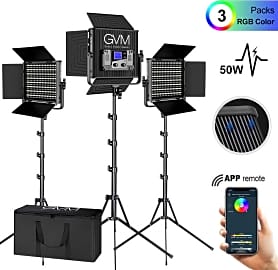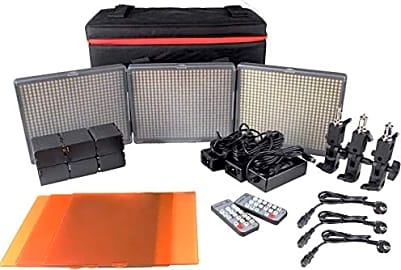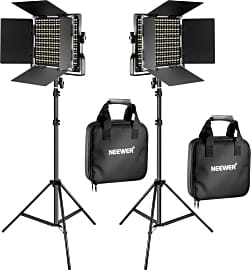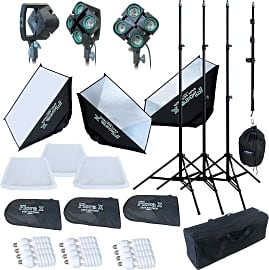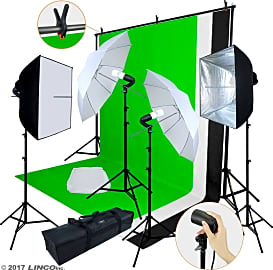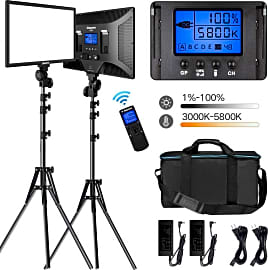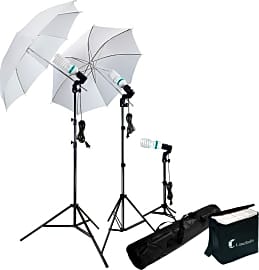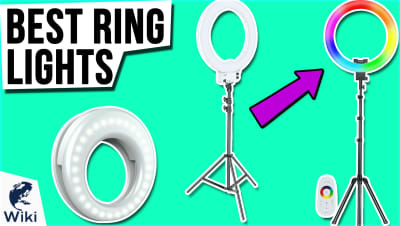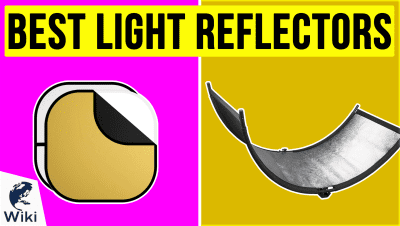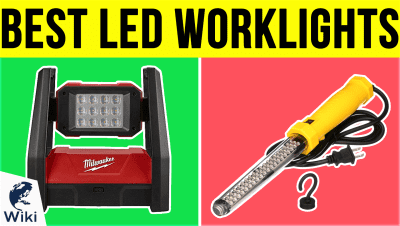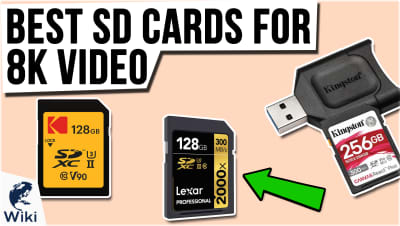The 10 Best Video Lighting Kits

This wiki has been updated 31 times since it was first published in January of 2018. If you're a creative artist working with moving images, then you will need a high-quality video lighting kit. The options on our list include sets for beginners looking to learn about how illumination affects their end results, as well as a few good choices for more experienced cinematographers. We've ranked them for you here by their output power, versatility, and durability. When users buy our independently chosen editorial recommendations, we may earn commissions to help fund the Wiki.
Editor's Notes
July 16, 2020:
With kits like these, you're going to see a lot of different ways to modify the light, and those can be as important to you as the brightness or adjustability of the lights themselves depending on your application. That's why we updated the Neewer Two-Piece 660 LED to a set that includes a pair of soft boxes. I've worked extensively with these Neewer lights, as well as their Bi-Color 480s, and I know they can get extremely harsh without diffusion. Those 480s left the list for wiring reasons, however, as the control knobs for one color sometimes unintentionally affected the settings of the other. And keep in mind that not all diffusion is created equal. We had to get rid of the Fotodiox model from our previous ranking for the difficulty in assembling its softboxes.
There's also size to consider, as larger light sources will provide softer light than smaller ones. In beauty lighting scenarios with models, for example, the Neewer High Power Dimmable are likely too small to serve as anything but hair lights, and even then you might want something a little bigger to provide consistency. Something like the Westcott Flex Mats or the Kino Flos in our special honors section are large enough to create professionally soft results.
March 27, 2019:
The flexibility and convenient barn doors on the Neewer 660s shot it up to a top spot on our list, while another product by the same company — the dimmable 2x160s — got a big demotion due to the limitations of their size. The Linco AM169 took the a similarly large hit, but for different reasons, as their background cloths are a little too small for a good deal of situations. Elsewhere, the unreliable nature of the stands that came with our old Westcott model sent that kit packing, and we replaced it with another offering from the same company — the 1X1 Flex Mats — which are rather exciting.
Special Honors
Kino Flo Lighting Systems Used in professional settings ranging from newsrooms to film sets, this company's offerings provide reliable illumination in a range of sizes and from several sources, including fluorescents and LEDs. Their RGB tube kits are among their most versatile offerings, as they can be placed in shots and disguised as practicals. You will have to pay for this kind of quality, however. kinoflo.com
The Importance Of Lighting For Video
If you're a videographer or cinematographer, there's a good chance that you spent a long time learning how to shoot beautiful images with little more than natural light.
If you're a videographer or cinematographer, there's a good chance that you spent a long time learning how to shoot beautiful images with little more than natural light. The advantages of natural light are numerous. Sunlight, especially from the right angle at the right time of day, can be incredibly flattering on your subjects, and staging events or actors by a window is one of the most reliable ways to create an attractive scene.
Only adding to this reliance on natural light is the increased sensitivity of the sensors built into most video cameras. That includes smaller DSLRs that are affordable enough for even amateur cinematographers to cut their teeth at high ISO levels that produce minimal noise.
But if you look closely at a lot of these videos shot at night with wide-open apertures or out in the field at the wrong time of day, you may begin to notice some important differences compared to the quality of images you see on professional film. That's in part because the majority of Hollywood cinema is shot at an aperture somewhere between f/4 and f/8 so that actors don't have to hit such minuscule marks to stay in focus and so that the act of following focus appears much smoother and more professional.
It's also due to the fact that Hollywood productions — whether they're high-key comedies or low-key dramas — are mostly lit with traditional three-point lighting. That means there is a strong light hitting the actor's face on one side (the key), with a slightly weaker light hitting them on the other side (the fill). A third light shines from behind to add depth and dimension by separating the actor from his or her background. This kind of lighting can be achieved through natural means when indoors if practical lamps and windows are placed just right within the frame, but it's far easier to achieve this effect with a good video lighting kit.
The addition of even a few more powerful lights to your cinematography arsenal will also allow you to turn down that ISO setting a bit. That means your nighttime and indoor video will suffer from less noise in the image, saving you valuable time in post-production and ensuring the highest quality picture. Having lights that you can manipulate also gives you more creative freedom than you would have if you were merely relying on natural sources. You can place lights at odd angles and distances, put gels of strange colors in front of them, and experiment with them until you develop a style uniquely your own.
It may take a little time for you to wrap your head around some of the technical aspects of lighting like degrees of fall off, the inverse relationship between harshness and distance, and the ever-present and always artificial-looking hard shadows, but the more time you spend with them the better you'll get. And before you know it, you'll be looking down on all those shooters who rely on nothing more than the Sun.
What To Look For In A Video Lighting Kit
When it comes time to actually invest in a video lighting kit, there are a lot of variables differentiating one system from next. Exactly what it is you plan on shooting should bear the most influence on what kind of kit you build from the ground up.
The accessories that come with a video lighting kit will have a lot to do with your ability to shape and soften the light to your liking.
For example, if you are an indie filmmaker with an explicit interest in moody dramas, large LED panels may not be your best choice, as these provide wide, even spreads of light that may add too much exposure to your scene. You would probably be better off with something more directional, like a set of small fresnel spot lights, that you can use to create slashes and angles of light with deep, sudden fall off or high-contrast, Film Noir-inspired settings. Also, for run-and-gun indies, battery power is a big plus.
If, on the other hand, you're shooting something that requires more even lighting, like broad comedy or YouTube videos set in front of a green screen, LED panels will likely be your best friends. They will provide you with good exposure on both your subjects and their environment. This is particularly important when shooting in front of a green screen, as bright, even lighting against a green screen will allow you to manipulate it more effectively in post.
The accessories that come with a video lighting kit will have a lot to do with your ability to shape and soften the light to your liking. Many include softboxes that will help spread the light, while also reducing the harshness of background shadows and the intensity with which that light bounces off your subjects. Some may also include barn doors that are excellent for shaping light and that also provide flags to cut down on lens flare and other issues. Keep an eye on the stands that your kit comes with, as well. Ideally, they will be able to reach a decent height and be outfitted with standard 1/4-20 male threaded mounts.
Other Ways To Up Your Video Quality
Now that you've decided to become an expert in video lighting, there are aa few things in addition to the lighting kit itself that can help maximize the quality of your video. There are the obvious things like better quality cameras and lenses, but we want to take a look at some additional tips and accessories you can use to increase your picture quality without spending a fortune.
They also happen to be particularly inexpensive, which is always a plus.
A good 7-in-1 reflector is paramount. These are lightweight, easy to transport, and incredibly effective at everything from bouncing light in a variety of colors to providing shade and diffusion on an actor in the sun. They also happen to be particularly inexpensive, which is always a plus.
You may be tempted to skip the lights designed for video and simply invest in some LED worklights, as these are particularly powerful and oftentimes less expensive than professional video lights. We won't necessarily discourage that behavior, but as soon as you get those lights home make sure that you test them with your camera, as many LED lights not designed for video will cause strange shadows or irrepressible flickering that would render them useless.


